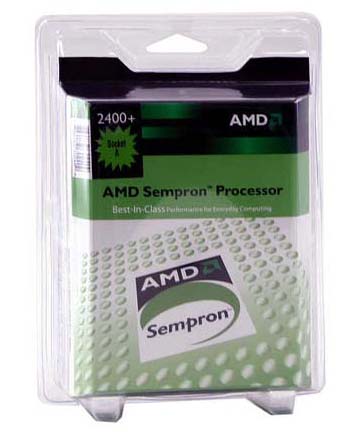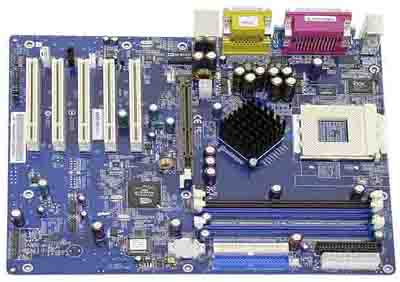Buyer's Guide - Entry Level, October 2004
by Jarred Walton on October 6, 2004 12:05 AM EST- Posted in
- Guides
CPU and Motherboard: Budget Office
For many years, if you wanted to keep up with computing trends you had to be willing to upgrade. This could range from replacing a few parts to purchasing an entirely new system. While that might not be a problem for some, for others it was a difficult proposition. Back in the 80s and 90s, buying a new computer every year or two could cost as much as a used automobile (although reliability might be a concern). Thankfully - depending on whom you ask - things have started to slow down. Many businesses continue to run two or three year old PCs with no real need to upgrade. Any processor running 1 GHz or faster is more than sufficient for surfing the net, writing email, and doing miscellaneous office work. It may not set any speed records, but other than an initial delay while starting up, most office applications spend most of their time waiting on the user.
Office CPU: AMD Sempron 2400+ 256K 1.67 GHz 333 MHz bus
Price: $65 shipped (Retail)
Our recommendation for this month's budget CPU goes to the AMD Sempron 2400+. The Sempron is basically a tweaked version of the venerable Athlon XP Thoroughbred core. Do not let the names confuse you; the Sempron family is meant to compete with the Intel Celeron line of processors and it actually runs at the same speed as the Athlon XP 2000+. However, the Sempron does use a faster 333 MHz bus, which can improve performance slightly, and since the two chips are basically the same price, there is little reason not to opt for the faster bus.
Should you wish to spend a little more on a faster processor, the Athlon XP 2500+ is still a reasonable purchase at roughly $25 more than the Sempron 2400+. It increases clock speed and doubles the amount of cache. However, AMD has recently started to phase out the Athlon XP processors and shift production to the Sempron and Athlon 64 lines, so Athlon XP prices are starting to rise. If you really want to pick up a Barton core Athlon XP, we recommend that you act sooner rather than later - the 2500+ has gone from a low of $75 a few months back to $90.
The Celeron D processor from Intel is also available at relatively low prices, but the price/performance ratio is usually lower than Athlon XP/Sempron. For those who simply have to run an Intel CPU, they are a reasonable alternative. Intel motherboards also tend to cost a little more, so the net result is that $20 will buy a Celeron D 320 and i865PE motherboard which may be slightly faster than the Sempron 2400+. The same $20 would also buy an Athlon XP 2500+, which would be another bump up in speed from the Celeron D 320. We recommend that you stay away from the older Celeron processors, however, as they use a slower bus and have 128K of L2 cache, which really hurts their performance.
Choosing a motherboard in this price segment is extremely difficult. Socket A has been around for over four years now and there have been dozens of chipsets both with and without integrated graphics. If saving money is your top priority, you might want to find an Nforce2 IGP motherboard, as it remains to this day to be one of the best integrated graphics solutions. Prices for these motherboards tend to be around $70 to $80. You will also find numerous refurbished motherboards available at a discount, but we prefer to stick with new models with their longer warranties.

Office Motherboard:Shuttle AN35N-Ultra
Price: $58 shipped
Shuttle gets the nod for our budget motherboard this time, as it includes more high-end features while still providing good reliability and performance. There may be other motherboards that are 1 or 2% faster, but they tend to cost more. The Shuttle features the more advanced Nforce2 Ultra chipset, which provides support for dual-channel memory. Should you be willing to spend a little more money, there are dozens of other motherboards that will work equally well and include additional features like SATA, IEE1394 (Firewire), RAID, and higher quality audio. However, none of those features are necessary and they increase the price slightly.
Update: If you read this guide earlier, you may have seen the Asus A7N8X-X recommended. Some of our readers were good enough to remind us that this board does not support dual-channel RAM. While it might only make a 3 to 5% difference in performance, the Shuttle supports this feature and costs less, and we have no problem wiht recommending it as in place of the ASUS. Abit, Albatron, ASRock, Chaintech, MSI, and quite a few other companies provide good motherboards at very low prices. The only feature that we still insist on for any socket A motherboard is that it use an Nforce2 chipset. Not even the new KT880 is able to fully match the performance of the Nforce2, and since they remain roughly the same price, why settle?










53 Comments
View All Comments
skittlekiller - Wednesday, October 6, 2004 - link
One thing that may be useful to inform buyers of is Miscrosoft's basic $15 optical mouse. I work with these very often, I find them to almost compete with Mice like my personal MX510. They're very nice, comfortable, and cheap. They'll do everything you want them to do, and will last you forever.JarredWalton - Wednesday, October 6, 2004 - link
ksherman - even inexpensive SFF cases can cost $200 or more, and they are usually more difficult to work with (since they're cramped). For first time buyers, it is difficult to recommend a SFF. If you know what you're doing, though, go for it. We're still looking into recommendations for a SFF System. Stay tuned.We could also cut the gaming system down to $750 while sticking with the 9800 Pro if we go with a cheaper case, monitor, 80GB HDD, and socket A. The performance will suffer a lot, though, especially in the most recent games. A 9800 Pro is still 50% faster (or more) than a 9600XT, so the extra $70 is money well spent, especially if you have any interest in gaming. If you get a 9600XT, high detail modes really are not an option for the latest generation games (Doom 3, HL2, Far Cry, etc.) That's just our opinion, though, and we do mention the 9600 Pro/XT as an option.
JarredWalton - Wednesday, October 6, 2004 - link
I made a few minor tweaks after reading the comments. I remember reading before that the A7N8X-X was single-channel only, but it's easy to forget with the similarity in names. Still, it's not like the single-channel mode really hurts performance, but with the suggestion of dual-channel RAM, we ought to stick with a board that supports the feature. Sorry for the confusion.Regarding case and monitor, I tried to make it clear that there are a LOT of options out there, and I don't think any two components are as personal a choice as those items. If money is an issue - and on a budget sytem, it almost certainly is - check out some local computer shops. You have to pay taxes, but you save on shipping, so it usually equals out. Searching for displays - both CRT and LCD - at local stores is also a good idea, especially if you have any large electronics stores like Fryes, CompUSA, or similar in the area. They often have sales on parts that can beat any online purchase.
ksherman - Wednesday, October 6, 2004 - link
I think that $900 for an entry level gaming system is a little much... why not use a 9600XT (which still kicks, but costs signifigantly less) and an AMD XP 2600, that only costs $75 and still performes well for games. Also, a SFF computer should be considered as an entry level PC, and should have been inluded... but otherwise, i like the review!Ballistics - Wednesday, October 6, 2004 - link
If you are looking for a 17" CRT monitor that can do high rez at high refresh rates look no further than the Viewsonic G75F. 1600 X 1200 @68 Hz and 1280 X 1024 @ 80 Hz. Natch!thebluesgnr - Wednesday, October 6, 2004 - link
This article shows socket A is not quite dead yet - I wonder why AnandTech completely ignored the KT880 chipset.For what it's worth, I'd recommend ASRock's K7V88 instead of the ASUS A7N8X-X. Save almost $20 for a stable board with SATA support, better sound codec.
btw, the A7N8X-X doesn't support dual-channel like page 4 of the article says.
MemberSince97 - Wednesday, October 6, 2004 - link
Very clear and informative Jarred. A concise guide for they noobler and confused first time PC builder...jensend - Wednesday, October 6, 2004 - link
Seagate's recent PATA drives have all been the sucks. See storagereview.com. For PATA, go Samsung P80- same price, 3-year warranty, significantly better performance (25% or greater difference in every DriveMark 2002 test), lower noise (for details on that, see silentpcreview.com). Seagate's SATA drives are considerably better and I'd call them a dead draw with Samsung's (slightly faster than the P80 SATA drives, slightly louder and slightly more expensive).Spacecomber - Wednesday, October 6, 2004 - link
"... the NEC FE771 is the same display [as the NEC 770] only with a beige enclosure."Actually, I believe that the NEC 770 is a shadow mask monitor, and the NEC 771 uses the Diamondtron aperture grill tube. Both models came in different colors.
Just being picky. I enjoyed reading the write-up.
Space
Illissius - Wednesday, October 6, 2004 - link
Solid recommendations. Why, though, do you insist on presenting two completely seperate price guides under the guise of a single one? It would be much simpler to, rather than have two pages for everything within the same guide, seperate it into two.